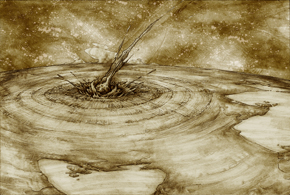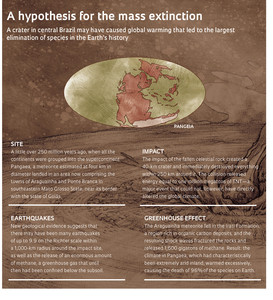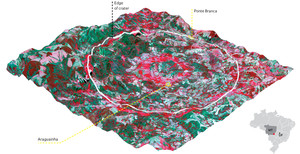 Sandro CastelliThe Earth has witnessed five major mass extinction events in the past half-billion years. The most recent and best-known of such events, about 65 million years ago, killed 75% of all living species, including the dinosaurs. Climate impacts caused by a fallen meteorite that left a 180-kilometer crater near the coast of what is now Mexico are usually cited as the probable cause of this large-scale annihilation, which marks the end of the Cretaceous period. But this event was not the most traumatic episode for the planet’s biodiversity.
Sandro CastelliThe Earth has witnessed five major mass extinction events in the past half-billion years. The most recent and best-known of such events, about 65 million years ago, killed 75% of all living species, including the dinosaurs. Climate impacts caused by a fallen meteorite that left a 180-kilometer crater near the coast of what is now Mexico are usually cited as the probable cause of this large-scale annihilation, which marks the end of the Cretaceous period. But this event was not the most traumatic episode for the planet’s biodiversity.
A little over 250 million years ago, before dinosaurs and mammals existed and all of the present-day continents were part of the ancient supercontinent Pangaea, 96% of the species on Earth perished as a result of one or more mysterious, tragic events. According to a paper recently published by researchers from Australia, the United Kingdom and Brazil in the scientific journal Palaeogeography, Palaeoclimatology, Palaeoecology, the largest known mass extinction, signaling the end of the Permian period, may have been triggered by the indirect effects of the creation of a 40-km diameter crater in the area now comprising the towns of Araguainha and Ponte Branca, in the southeastern part of the Brazilian state of Mato Grosso near its border with the state of Goiás.
 The collision per se of the approximately 4-km diameter meteorite that created this enormous scar on the landscape of Central Brazil known as the Araguainha dome or crater did not have the potential to end life on a global scale. The energy produced by the impact of the celestial rock with the Earth’s surface must have instantly destroyed everything within a radius of up to 250 km around it. “The impact of the meteorite in Araguainha could not have caused a global mass extinction,” says geologist Eric Tohver of the University of Western Australia, first author of the study, who worked with a team from the University of São Paulo (USP). “But its indirect effects could have done so.”
The collision per se of the approximately 4-km diameter meteorite that created this enormous scar on the landscape of Central Brazil known as the Araguainha dome or crater did not have the potential to end life on a global scale. The energy produced by the impact of the celestial rock with the Earth’s surface must have instantly destroyed everything within a radius of up to 250 km around it. “The impact of the meteorite in Araguainha could not have caused a global mass extinction,” says geologist Eric Tohver of the University of Western Australia, first author of the study, who worked with a team from the University of São Paulo (USP). “But its indirect effects could have done so.”
Earthquakes and tsunamis
A series of events caused by the impact could have triggered rapid and fatal global warming in a matter of days. Nature and the extent of the area covered by certain sedimentary deposits appear to indicate that they were caused by tsunamis. Other geological evidence suggests that there may have been many earthquakes measuring up to 9.9 on the Richter scale in a radius of 1,000 km around the crater. The strong tremors likely fractured the organic-carbon-rich rocks of the Irati Formation, which includes the area around Araguainha, and released an enormous amount of methane, a greenhouse gas.
 Carlos Roberto de Souza Filho/UnicampAccording to the researchers’ calculations, 1,600 gigatons of methane—nearly five times more than the amount spilled out over the planet since the beginning of the Industrial Revolution 250 years ago—were released into the atmosphere in only a matter of days. A recent discovery by the researchers lends support to that idea. The rocks in the region have a strange isotopic signature: they have scant amounts of carbon-12 but are rich in carbon-13. The explanation for this anomaly is that they released a large amount of methane—of which carbon is a component—into the atmosphere.
Carlos Roberto de Souza Filho/UnicampAccording to the researchers’ calculations, 1,600 gigatons of methane—nearly five times more than the amount spilled out over the planet since the beginning of the Industrial Revolution 250 years ago—were released into the atmosphere in only a matter of days. A recent discovery by the researchers lends support to that idea. The rocks in the region have a strange isotopic signature: they have scant amounts of carbon-12 but are rich in carbon-13. The explanation for this anomaly is that they released a large amount of methane—of which carbon is a component—into the atmosphere.
If the air was suddenly filled with methane, global warming in Pangaea—which already had a characteristic climate of extremes, especially in its arid central region where temperatures exceeded 60ºC—would have occurred so suddenly that few life forms could have adapted to the new environmental conditions. “The end-Permian mass extinction is generally attributed to changes resulting from volcanic activity and lava release,” says geologist Ricardo Trindade of the Institute of Astronomy, Geophysics and Atmospheric Sciences (IAG) at USP, a co-author of the study, which was funded in part by FAPESP. “But our hypothesis indicates that the Araguainha crater could have played a significant, if indirect, role in that process.”
The possibility that a meteorite may have triggered global climate change that led to the largest extinction of life on Earth immediately brings to mind the story of the disappearance of the dinosaurs. Did history repeat itself in the Permian and Cretaceous extinctions? There are similarities in the two situations: fallen space rocks and the respective craters could have caused climate change that played a role in the two extinction processes. But not everything would have been exactly the same. The dynamics of each event would have been unique.

Eric TohverThe Araguainha dome as seen from the crater area: a region rich in organic carbon depositsEric Tohver
The meteorite that fell 65 million years ago on the Yucatán Peninsula was at least 10 km in diameter and created the Chicxulub crater, which is nearly five times larger than the Araguainha crater. The energy produced by the impact of that celestial rock in and of itself was millions of times greater than that of an atomic bomb. For this reason alone, the impact of the meteorite caused a serious alteration in the dynamics of the Earth. The amount of dust produced by the explosion would likely have prevented solar radiation from reaching the Earth, catapulting the planet into a nuclear winter characterized by darkness and extreme cold.
The mass extinction in Pangaea involved a number of unique aspects, according to a new hypothesis conceived by Tohver, Trindade and their colleagues. The direct impact of the Araguainha meteorite purportedly had only regional destructive effect. The effects on global climate were caused by the series of earthquakes that caused the rocks of the Irati Formation to release methane, thus intensifying the greenhouse effect. Under those circumstances, the Permian mass extinction would have been caused by climate warming, while the Cretaceous extinction would have been triggered by cooling. “It was by chance that the meteorite fell in a region rich in organic carbon,” Tohver comments.

ERIC TOHVERShatter cones in Araguainha: evidence that a meteorite created the craterERIC TOHVER
A revised age for the crater
Until last year it would have been unthinkable to even link the Permian mass extinction to possible changes arising from the emergence of the Araguainha dome, Brazil’s largest and oldest crater confirmed to have been caused by the impact of a meteorite (see discussion on page 21 about the craters discovered to date in Brazil). Its age was estimated at 245 million years, that is to say, geologists believed that the crater formed after the mass die-offs of species. The modernized dating techniques that Tohver and his Brazilian colleagues used and presented in the journal Geochimica et Cosmochimica Acta in June 2012, however, provided a more accurate age for the scar left by the meteorite in central Brazil: 254.7 million years, with a ±2.5 million year margin of error. Since the Permian extinction occurred 252.2 million years ago, the Araguainha crater may have been created a short time before the mass species extinction. “There is no other crater in the world from this same Permian-Triassic transition period,” explains geologist Cristiano Lana of the Federal University of Ouro Preto (UFOP), another co-author of the paper.
The search for the source of a phenomenon so large-scale as to cause the annihilation of nearly every form of life on Earth 250 million years ago is not a trivial task, and any hypothesis in that regard is likely to invite criticism and controversy. Geologist Alvaro Penteado Crósta of the University of Campinas (Unicamp), a leading scholar on Brazilian craters, believes that more data are needed in order to link the Permian extinction to indirect effects of the emergence of the Araguainha dome. “It’s an interesting hypothesis, but there is no evidence that the amount of organic matter in the rocks of that region (the Irati Formation) was sufficient to release such a large quantity of methane,” Crósta says. “In addition, the process of methane release as a result of seismic waves, as proposed by the authors, would need to be more thoroughly studied, as would the proposal that large-magnitude tsunamis were propagated several thousands of kilometers away in a shallow water environment, which would be unlikely.” According to geologist Claudio Riccomini of the Geosciences Institute (IGc) at USP, another co-author of the study on the possible role of Araguainha in the Permian extinction, the Irati Formation has up to 20% organic carbon, which makes this a reasonable hypothesis.

ERIC TOHVERFossilized bones: a sample of local lifewERIC TOHVER
Some researchers maintain that this was not the cause of the extinction, but that there may have been several causes, including meteorite impact, volcanic activity and changes in sea level. “In the opinion of those who advocate multicausality for the phenomenon, it was in fact the combination of effects, and not necessarily the intensity of each one, that caused such a large-scale extinction. In that case, however, the main problem is demonstrating the concurrence between the various causes and determining the threshold point that led to the extinction,” says paleontologist Cesar Schultz of the Federal University of Rio Grande do Sul (UFRGS). “In that sort of context, any one of the causes could have been the ‘drop of water’ that caused the glass to overflow. Although we can debate whether the intensity of the Araguainha impact was great enough in and of itself to cause extinction, it could have been that ‘drop of water.’” Schultz points out, however, that the time difference between the age attributed to the meteorite impact in Araguainha and the Permian mass extinction of species is on the edge of the margin of error for the method used by Tohver and the USP group. That is an additional complicating factor, according to the paleontologist, because the authors propose an immediate cause-and-effect relationship between the impact of the extraterrestrial rock and the climate changes that led to the extinction.
Project
Geophysical and petrophysical characterization of the Araguainha impact structure (No. 2005/51530-3); Grant mechanism Regular Line of Research Project Award; Coord. Yára Regina Marangoni/IAG-USP; Investment R$217.201.69 (FAPESP).
Scientific articles
TOHVER, E. et al. Shaking a methane fizz: Seismicity from the Araguainha impact event and the Permian–Triassic global carbon isotope record. Palaeogeography, Palaeoclimatology, Palaeoecology. Published online on June 18, 2013.
TOHVER, E. et al. Geochronological constraints on the age of a Permo–Triassic impact event: U–Pb and 40Ar/39Ar results for the 40 km Araguainha structure of central Brazil. Geochimica et Cosmochimica Acta. v. 86, n. 1, p. 214-27. June 2012.